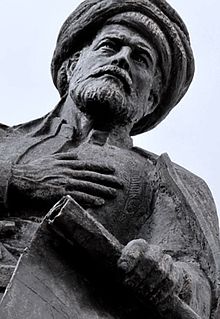
Back بيري ريس Arabic بيرى ريس ARZ Piri Rəis Azerbaijani پیری رییس AZB Пири Реис Bulgarian পিরি রেইস Bengali/Bangla Piri Reis Catalan پیری ڕەئیس CKB Piri Reis Corsican Piri Reis Czech
Piri Reis | |
|---|---|
 Statue of Piri Reis | |
| Born | Muhiddin Piri c. 1470 |
| Died | 1553 (aged 82–83) Cairo, Egypt Eyalet, Ottoman Empire |
| Notable work | |
| Relatives | Kemal Reis (uncle) |

Muhiddin Piri (c. 1470 – 1553), better known as Piri Reis (Turkish: Pîrî Reis), was an Ottoman cartographer, admiral, navigator, corsair, and geographer. He is primarily known today for his cartographic works, including his 1513 world map and the Kitab-ı Bahriye (Book of the Sea), a book with detailed information on early navigational techniques as well as relatively accurate charts for their time, describing the ports and cities of the Mediterranean Sea.
He was born in Gallipoli—a major Ottoman naval base—and sailed from an early age with his uncle Kemal Reis. They fought as corsairs in the Western Mediterranean until they were brought into the Ottoman Navy. Piri Reis fought alongside Kemal Reis in the Ottoman–Venetian wars. When his uncle died in 1511, Piri Reis returned to Gallipoli to begin his cartographic works. He created his first world map and likely began drafting the charts and notes that would form the basis of the Kitab-ı Bahriye. By 1516, he returned to the navy and took part in the Ottoman conquest of Egypt. After their victory, he presented the world map to Sultan Selim I. When Suleiman the Magnificent became sultan, Piri Reis completed the first version of the Kitab-ı Bahriye, which he dedicated and gifted to the sultan by 1521. Several years later, he created a more elaborate version at the urging of Grand Vizier Pargalı Ibrahim Pasha. His final surviving work is a 1528 world map, of which only the northwest corner remains (showing Greenland, Labrador, Newfoundland, Florida, Cuba, Hispaniola, Jamaica, and Central America).
In 1546, Piri Reis became Hind Kapudan-ı Derya, or grand admiral of the Ottoman Fleet in the Indian Ocean, as well as admiral of the fleet in Egypt. He expanded the Indian Ocean fleet, retook several ports, and pushed the Portuguese out of the Red Sea. In the 1550s, he began a campaign to capture the Portuguese-controlled Hormuz Island at the mouth of the Persian Gulf. He abandoned the siege of Hormuz after several weeks, sacked the city, and looted the nearby Qeshm Island, where wealthy residents of Hormuz had evacuated. For failing to capture Hormuz, he was executed in 1553 in Cairo.
His cartographic work received little appreciation during his own life. There is no evidence that the Kitab-ı Bahriye circulated outside the royal palace before 1550. After his death, hundreds of copies of the book were likely made. Over 40 copies survive today, spanning several centuries. When his 1513 world map was unearthed at the Topkapı Palace in Istanbul, it drew international attention. The map relies on many sources, including a lost map of the Caribbean from Christopher Columbus. This sparked greater interest in the Kitab-ı Bahriye, and facsimiles of both were published. Piri Reis and his cartography have since become a point of national pride for Turkey.